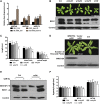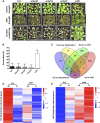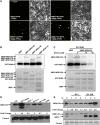Arabidopsis WRKY46, WRKY54, and WRKY70 Transcription Factors Are Involved in Brassinosteroid-Regulated Plant Growth and Drought Responses
- PMID: 28576847
- PMCID: PMC5502465
- DOI: 10.1105/tpc.17.00364
Arabidopsis WRKY46, WRKY54, and WRKY70 Transcription Factors Are Involved in Brassinosteroid-Regulated Plant Growth and Drought Responses
Abstract
Plant steroid hormones, brassinosteroids (BRs), play important roles in growth and development. BR signaling controls the activities of BRASSINOSTERIOD INSENSITIVE1-EMS-SUPPRESSOR1/BRASSINAZOLE-RESISTANT1 (BES1/BZR1) family transcription factors. Besides the role in promoting growth, BRs are also implicated in plant responses to drought stress. However, the molecular mechanisms by which BRs regulate drought response have just begun to be revealed. The functions of WRKY transcription factors in BR-regulated plant growth have not been established, although their roles in stress responses are well documented. Here, we found that three Arabidopsis thaliana group III WRKY transcription factors, WRKY46, WRKY54, and WRKY70, are involved in both BR-regulated plant growth and drought response as the wrky46 wrky54 wrky70 triple mutant has defects in BR-regulated growth and is more tolerant to drought stress. RNA-sequencing analysis revealed global roles of WRKY46, WRKY54, and WRKY70 in promoting BR-mediated gene expression and inhibiting drought responsive genes. WRKY54 directly interacts with BES1 to cooperatively regulate the expression of target genes. In addition, WRKY54 is phosphorylated and destabilized by GSK3-like kinase BR-INSENSITIVE2, a negative regulator in the BR pathway. Our results therefore establish WRKY46/54/70 as important signaling components that are positively involved in BR-regulated growth and negatively involved in drought responses.
© 2017 American Society of Plant Biologists. All rights reserved.
Figures







References
-
- Cai Z., Liu J., Wang H., Yang C., Chen Y., Li Y., Pan S., Dong R., Tang G., Barajas-Lopez Jde.D., Fujii H., Wang X. (2014). GSK3-like kinases positively modulate abscisic acid signaling through phosphorylating subgroup III SnRK2s in Arabidopsis. Proc. Natl. Acad. Sci. USA 111: 9651–9656. - PMC - PubMed
MeSH terms
Substances
Grants and funding
LinkOut - more resources
Full Text Sources
Other Literature Sources
Molecular Biology Databases

